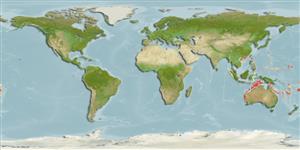Klassifizierung / Names
Namen | Synonyme | Catalog of Fishes(Gattung, Arten) | ITIS | CoL | WoRMS | Cloffa
>
Perciformes/Uranoscopoidei (Sand dwellers) >
Pinguipedidae (Sandperches)
Etymology: Parapercis: Greek, para = the side of + Greek, perke = perch (Ref. 45335); rubricaudalis: Name from Latin 'rubri' for red and 'caudalis' for caudal
fin; referring to thered lower portion of the caudal fin.
Environment: milieu / climate zone / depth range / distribution range
Ökologie
seewasser riff-verbunden; tiefenbereich 70 - 119 m (Ref. 116166). Subtropical
Verbreitung
Länder | FAO Gebiete | Ecosystems | Vorkommen | Point map | Einführungen | Faunafri
Indo-West Pacific: Western Australia and the Philippines.
Size / Gewicht / Alter
Maturity: Lm ? range ? - ? cm
Max length : 6.9 cm SL Männchen/unbestimmt; (Ref. 116166)
Kurzbeschreibung
Bestimmungsschlüssel | Morphologie | Morphometrie
Rückenflossenstacheln (insgesamt) : 5; Rückenflossenweichstrahlen (insgesamt) : 21; Afterflossenstacheln: 1; Afterflossenweichstrahlen: 17; Wirbelzahl: 30. This species is distinguished by the following characters: D V, 21; A I,17; pectoral-fin rays 15-17
(rarely 15 or 17); lateral-line scales 56-58 (modally 57); gill rakers 2-4 + 7-10 = 9-14; predorsal scales 4-6 (modally 5); ctenoid scales on cheek; canine teeth 6 in outer row at front of lower jaw; robust and conical vomer teeth in 1-2 irregular rows; no palatine teeth; opercle with 2-3 strong spines; margin of preopercle, subopercle and interopercle are strongly serrated; vertebrae - 10 abdominal and 20 caudal; pelvic fins reaching between vent and base of third anal-fin ray; 3 broad orange to reddish bars on head between suborbital and opercle, 6 irregular broad orange to reddish transverse bands across body, 2-3 rows of red spots on soft dorsal fin, anal-fin reddish infused with yellow near base, a large red blotch on anteroventral quarter of pectoral fin, pelvic fins are bright orange-red, and caudal fin with several irregular rows of dark red spots, the lower third of fin distinctively crimson-red (Ref. 116166).
Life cycle and mating behavior
Geschlechtsreife | Fortpflanzung | Ablaichen | Eier | Fecundity | Larven
Johnson, J.W. and H. Motomura, 2017. Five new species of Parapercis (Perciformes: Pinguipedidae) from southeast Asia and northwest Australia. Zootaxa 4320:121-145. (Ref. 116166)
IUCN Rote Liste Status (Ref. 130435: Version 2024-1)
Bedrohung für Menschen
Harmless
Nutzung durch Menschen
Fischereien:
Tools
Zusatzinformationen
Download XML
Internet Quellen
Estimates based on models
Phylogenetic diversity index (Ref.
82804): PD
50 = 0.5000 [Uniqueness, from 0.5 = low to 2.0 = high].
Bayesian length-weight: a=0.00692 (0.00314 - 0.01524), b=3.06 (2.88 - 3.24), in cm total length, based on LWR estimates for this Genus-body shape (Ref.
93245).
Trophic level (Ref.
69278): 3.3 ±0.4 se; based on size and trophs of closest relatives
Widerstandsfähigkeit (Ref.
120179): hoch, Verdopplung der Population dauert weniger als 15 Monate. (Preliminary K or Fecundity.).
Fishing Vulnerability (Ref.
59153): Low vulnerability (10 of 100).
